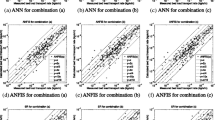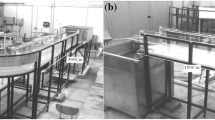Abstract
In natural alluvial channels, the determination of the flow resistance constitutes a problem with additional complexity compared to rigid bed channels, due to the bed morphology transformations and the alterations of the flow properties caused by sediment transport. While there have been steps towards understanding the processes that contribute to flow resistance in an alluvial channel, a robust quantitative model with wide applicability remains elusive. Machine learning offers the ability to exploit available data and generate equations that accurately describe the problem by taking implicitly into account the contributing mechanisms that are difficult to be modeled. In this paper, four machine learning techniques are employed for the mean flow velocity prediction, separately for sand-bed and gravel-bed rivers, namely artificial neural networks, adaptive-network-based fuzzy inference system, symbolic regression based on genetic programming, and support vector regression. The derived models are robust and their results are superior to those of some widely used flow resistance formulae, which compute the mean flow velocity from similar independent hydraulic variables.



Similar content being viewed by others
References
Alam AM, Kennedy JF (1969) Friction factors for flow in sand bed channels. J Hydraul Div 95(HY6):1973–1992
Azamathulla HM, Jarrett RD (2013) Use of gene-expression programming to estimate Manning’s roughness coefficient for high gradient streams. Water Resour Manag 27(3):715–729
Azamathulla HM, Ab Ghani A, Leow CS, Chang CK, Zakaria NA (2011) Gene-expression programming for the development of a stage-discharge curve of the Pahang River. Water Resour Manag 25(11):2901–2916
Baptist MJ, Babovic V, Rodriguez Uthurburu J, Keijer M, Uittenbogaard RE, Mynett A, Verwey A (2007) On inducing equations for vegetation resistance. J Hydraul Res 45(4):435–450
Bathurst JC (1985) Flow resistance estimation in mountain rivers. J Hydraul Eng 111(4):625–643
Bowden GJ, Maier HR, Dandy GC (2002) Optimal division of data for neural networks models in water resources applications. Water Resour Res 38(2):2–1–2–11
Brownlie WR (1981) Compilation of alluvial channel data: Laboratory and field. Tech. Rep. KH-R-43B, W.M. Keck Laboratory of Hydraulics and Water Resources. California Institute of Technology, Pasadena, California
Brownlie WR (1983) Flow depth in sand-bed channels. J Hydraul Eng 109(7):959–990
Camenen B, Bayram A, Larson M (2006) Equivalent roughness height for plane bed under steady flow. J Hydraul Eng 132(11):1146–1158
Campbell L, McEwan I, Nikora V, Pokrajac D, Gallagher M, Manes C (2005) Bed-load effects on hydrodynamics of rough-bed open-channel flows. J Hydraul Eng 131(7):576–585
Carbonneau PE, Bergeron NE (2000) The effect of bedload transport on mean and turbulent flow properties. Geomorphology 35(3-4):267–278
Chang CC, Lin CJ (2011) LIBSVM: A library for support vector machines. ACM Trans Intell Syst Technol 2(3):27:1–27:27. software available at http://www.csie.ntu.edu.tw/cjlin/libsvm
Dogan E, Tripathi S, Lyn DA, Govindaraju RS (2009) From flumes to rivers: Can sediment transport in natural alluvial channels be predicted from observations at the laboratory scale? Water Resour Res 45(8):W08,433
Einstein HA, Barbarossa NL (1952) River channel roughness. Trans, ASCE 117:1121–1132
Engelund F, Hansen E (1967) A monograph on sediment transport in Alluvial Streams. Teknisk Forlag, Copenhagen, Denmark
Ferguson R (2007) Flow resistance equations for gravel- and boulder-bed streams. Water Resour Res 43(5):W05,427
Garcia MH (2008) Sediment transport and morphodynamics. In: Garcia MH (ed) ASCE Manuals and Reports on Engineering No. 110, Sedimentation Engineering Processes, Measurements, Modeling and Practice, ASCE, Virginia, U.S.A., chap 2, pp 21–163
Geisser S (1993) Predictive inference. Chapman and Hall, New York
Giustolisi O (2004) Using genetic programming to determine Chezy resistance coefficient in corrugated channels. J Hydroinform 6(3):157–173
Hagan MT, Menhaj MB (1994) Training feedforward networks with the Marquardt algorithm. IEEE Trans Neural Netw 5(6):989–993
Haykin S (2009) Neural networks and learning machines, 3rd edn. Prentice Hall, New Jersey
Hey RD (1979) Flow resistance in gravel-bed rivers. J Hydraul Div 105(4):365–379
Hornik K, Stinchcombe M, White H (1989) Multilayer feedforward networks are universal approximators. Neural Netw 2(5):359–366
Iliadis L, Maris F, Tachos S (2011) Soft computing techniques toward modeling the water supplies of Cyprus. Neural Netw 24(8):836–841
Jang JSR (1993) ANFIS: Adaptive-network-based fuzzy inference system. IEEE Trans Syst Man Cybern 23(3):665–685
Jarrett RD (1984) Hydraulics of high-gradient streams. J Hydraul Eng 110(11):1519–1539
Karim F (1995) Bed configuration and hydraulic resistance in alluvial-channel flows. J Hydraul Eng 121(1):15–25
Keulegan GH (1938) Laws of turbulent flow in open channels. J Res Nat Bur Stand 21:707–741
Khullar NK, Kothyari UC, Ranga Raju KG (2007) Effect of wash load on flow resistance. J Hydraul Res 45(4):497–504
Kitsikoudis V, Hrissanthou V (2013) Artificial neural network modeling of the fractional transport rate of bed-load in gravel-bed streams. In: Proceedings of the 6th International Conference on Water Resources and Environment Research. Koblenz, Germany, pp 231–255
Kitsikoudis V, Sidiropoulos E, Hrissanthou V (2014a) Assessment of sediment transport approaches for sand-bed rivers by means of machine learning. Hydrol Sci J doi:10.1080/02626667.2014.909599. (accepted for publication)
Kitsikoudis V, Sidiropoulos E, Hrissanthou V (2014b) Machine learning utilization for bed load transport in gravel-bed rivers. Water Resour Manag 28(11):3727–3743
Kitsikoudis V, Sidiropoulos E, Iliadis L, Hrissanthou V (2014c) Calculation of sediment transport capacity of flowing water in rivers with machine learning. In: Proceedings of the 11th International Conference on Hydroscience and Engineering, Hamburg, Germany
Koza JR (1992) Genetic programming: on the programming of computers by means of natural selection. MIT Press, Cambridge, MA
Lamb MP, Dietrich WE, Venditti JG (2008) Is the critical Shields stress for incipient motion dependent on channel-bed slope? J Geophys Res 113:F02,008
Lyn DA (1991) Resistance in flat-bed sediment-laden flows. J Hydraul Eng 117(1):94–114
Maier HR, Jain A, Dandy GC, Sudheer KP (2010) Methods used for the development of neural networks for the prediction of water resource variables in river systems: Current status and future directions. Environ Model Softw 25(8):891–909
Morvan H, Knight D, Wright N, Tang X, Crossley A (2008) The concept of roughness in fluvial hydraulics and its formulation in 1D, 2D and 3D numerical simulation models. J Hydraul Res 46(2):191–208
Muller A (1973) Turbulence measurements over a movable bed with sediment transport by laser anemometry. In: Proceedings of the 15th IAHR Congress, Istanbul, Turkey, vol 1, pp A7–1–A7–7
Nash JE, Sutcliffe JV (1970) River flow forecasting through conceptual models, Part I - A discussion of principles. J Hydrol 10(3):282–290
Nikora V, Goring D (2000) Flow turbulence over fixed and weakly mobile gravel beds. J Hydraul Eng 126(9):679–690
Parker G, Anderson AG (1977) Basic principles of river hydraulics. J Hydraul Div 103(9):1077–1087
Pitlick J (1992) Flow resistance under conditions of intense gravel transport. Water Resour Res 28(3):891–903
Pyle D (1999) Data preparation for data mining. Morgan Kaufmann, San Francisco, California
Recking A (2009) Theoretical development on the effects of changing flow hydraulics on incipient bed load motion. Water Resour Res 45(4):W04,401
Recking A, Frey P, Paquier A, Belleudy P, Champagne JY (2008) Feedback between bed load transport and flow resistance in gravel and cobble bed rivers. Water Resour Res 44(5):W05,412
Rickenmann D, Recking A (2011) Evaluation of flow resistance in gravel-bed rivers through a large field data set. Water Resour Res 47(7):W07,538
Rouse H (1965) Critical analysis of open-channel resistance. J Hydraul Div 91(HY4):1–25
Searson DP (2009) GPTIPS; Genetic Programming and Symbolic Regression for MATLAB, User Guide
Shrestha RR, Simonovic SP (2010) Fuzzy nonlinear regression approach to stage-discharge analyses: Case study. J Hydrol Eng 15(1):49–56
Shvidchenko AB, Pender G (2000) Flume study of the effect of relative depth on the incipient motion of coarse uniform sediments. Water Resour Res 36(2):619–628
Smart GM, Jaeggi MNR (1983) Sediment Transport on Steep Slopes. Mitteilung der Versuchsanstalt für Wasserbau, Hydrologie und Glaziologie der ETH Zürich, Nr 64, Zurich, Switzerland
Smola AJ, Schölkopf B (2004) A tutorial on support vector regression. Stat Comput 14(3):199–222
Strickler A (1923) Beiträge zur Frage der Geschwindigkeitsformel und der Rauhigkeitszahlen für Ströme, Kanäle und Geschlossene Leitungen, Mitt. 16, Eidg. Amt für Wasserwirtsch., Bern, Switzerland
Sumer BM, Kozakiewicz A, Fredsoe J, Deigaard R (1996) Velocity and concentration profiles in sheet-flow layer of movable bed. J Hydraul Eng 122(10):549–558
van Ingen C (1981) Observations in a sediment-laden flow by use of laser-doppler velocimetry. Tech. Rep. KH-R-42, W.M. Keck Laboratory of Hydraulics and Water Resources. California Institute of Technology, Pasadena, California
van Rijn LC (1984) Sediment transport, part III: Bed forms and alluvial roughness. J Hydraul Eng 110(12):1733–1754
Vanoni VA (2006) ASCE Manuals and Reports on Engineering No. 54, Sedimentation Engineering. ASCE, Virginia, U.S.A
Vanoni VA, Nomicos GN (1960) Resistance properties of sediment-laden streams. Trans ASCE 125(1):1140–1167
Vapnik V (1995) The Nature of Statistical Learning Theory. Springer, New York
Wang X, Qian N (1989) Turbulence characteristics of sediment-laden flow. J Hydraul Eng 115(6):781–800
Werbos PJ (1990) Backpropagation through time: What it does and how to do it. Proc IEEE 78(10):1550–1560
Whiting PJ, Dietrich WE (1990) Boundary shear stress and roughness over mobile alluvial beds. J Hydraul Eng 116(12):1495–1511
Wilson KC (1987) Analysis of bed-load motion at high shear stress. J Hydraul Eng 113(1):97–103
Witten IH, Frank E, Hall MA (2011) Data mining: practical machine learning tools and techniques, 3rd edn. Morgan Kaufmann, Burlington, MA
Wu W, Wang SSY (1999) Movable bed roughness in alluvial rivers. J Hydraul Eng 125(12):1309–1312
Yang CT (2003) Sediment Transport: Theory and Practice. Original edition McGraw-Hill; 1996. Reprint edition by Krieger Publication Company, Malabar, FL
Yen BC (2002) Open channel flow resistance. J Hydraul Eng 128(1):20–39
Yu G, Lim SY (2003) Modified Manning formula for flow in alluvial channels with sand-beds. J Hydraul Res 41(6):597–608
Zadeh LA (1965) Fuzzy sets. Inf Control 8(3):338–353
Acknowledgments
The authors are grateful to an Associate Editor and two anonymous Reviewers for their constructive and insightful comments and suggestions, which improved the presentation of this paper.
Author information
Authors and Affiliations
Corresponding author
Rights and permissions
About this article
Cite this article
Kitsikoudis, V., Sidiropoulos, E., Iliadis, L. et al. A Machine Learning Approach for the Mean Flow Velocity Prediction in Alluvial Channels. Water Resour Manage 29, 4379–4395 (2015). https://doi.org/10.1007/s11269-015-1065-0
Received:
Accepted:
Published:
Issue Date:
DOI: https://doi.org/10.1007/s11269-015-1065-0




